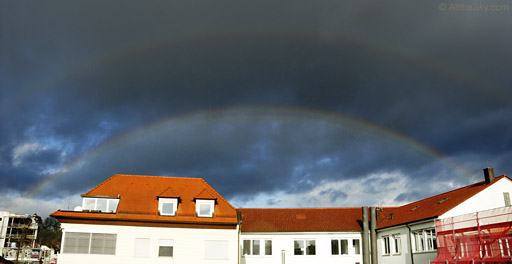Twinned Rainbow

|
zoom in
| Date: | 06.01.2008 | Camera: | Nikon D200, 17 mm |
|---|---|---|---|
| Place: | Tübingen, Germany | Photo: | T. Credner |
|
The image shows a primary rainbow and the typical secondary bow above. But if you look closely,
you also can see a twinning of the primary rainbow. This is not from
supernumerary arcs. It is a complete second primary bow with the largest
gap on top and a closing gap at the sides. There appears no visible twinning of the secondary rainbow.
The twinning might occur from two different water droplets, probably at two different distances. If the drops are non spherical but oblate from air resistance the primary bow flattens. So we might see two different populations of raindrops along the line of sight. Some drops were really close, you can see their streaks in the closeup. See also: Les Cowley on twinned bows |